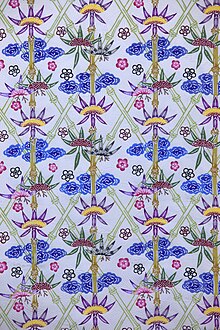Our website is made possible by displaying online advertisements to our visitors.
Please consider supporting us by disabling your ad blocker.
Bingata


Bingata (Okinawan: 紅型, literally "red style") is a traditional stencilled resist dyeing technique originating in Okinawa Prefecture. Bingata typically features a busy pattern of repeating nature motifs such as fish, flowers and fauna in a number of bright colours. Bingata is worn during traditional Ryukyuan festivals and traditional arts performances.
Bingata dates from the Ryūkyū Kingdom period (14th century), when the island of Okinawa experienced an influx of foreign goods and manufacturing techniques. It is believed to have developed as a synthesis of Indian, Chinese, and Javanese dyeing processes.
Previous Page Next Page


